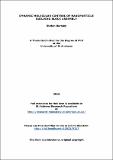Dynamic molecular control of nanoparticle building block assembly
Abstract
Nanoparticles have generated much excitement as a result of their often unique
properties, inherently dependent on nanoparticle material, shape and size.
Virtually all conceivable nanoparticle applications will require excellent control
over how nanoparticles are assembled and linked to other components. When
several nanoparticles are brought together, the assembly structure is crucial in
determining their newly emergent properties. However, the synthetic chemistry
techniques required to control nanoparticle functionalisation and assembly are
still under-developed, with complex biological or supramolecular systems being
the current best approaches. There remains a need for simple, generalisable
strategies for molecular-level control over nanoparticle functionalisation and
assembly. This thesis presents the development of a toolkit of nanoparticle
building blocks, which may be assembled in a predictable and controlled way,
governed by simple and easily optimised abiotic molecular systems.
Efficient, size-controlled, direct synthesis of functionalised gold nanoparticle
building blocks with control over size and dispersity is developed.
¹⁹F NMR spectroscopy studies provide a fundamental understanding of the implications
of confinement at the nanoparticle surface for molecular reactivity. Two self-assembly strategies, each resulting in structures of high order and predictability,
are presented. First, the reversible nature of dynamic covalent boronic ester
formation is exploited to induce reversible nanoparticle self-assembly. Links
between molecular details and resulting morphology are demonstrated and
rationalised. A second strategy exploits multivalent non-covalent interactions,
resulting in ‘planet–satellite’ structures displaying high order, stability and
predictability.
This thesis demonstrates that relatively simple molecular systems present a
viable, and ultimately more flexible, alternative to existing methods of directing
precise, predictable control of nanoparticle functionalisation and assembly.
Advancing a molecular-level understanding of the underlying processes enables a high level of control. Future application of this molecular approach to dynamic nanomaterial control will lead to more complex and sophisticated
nanostructures, helping nanotechnology progress towards its undoubtedly
revolutionary full potential.
Type
Thesis, PhD Doctor of Philosophy
Collections
Items in the St Andrews Research Repository are protected by copyright, with all rights reserved, unless otherwise indicated.

